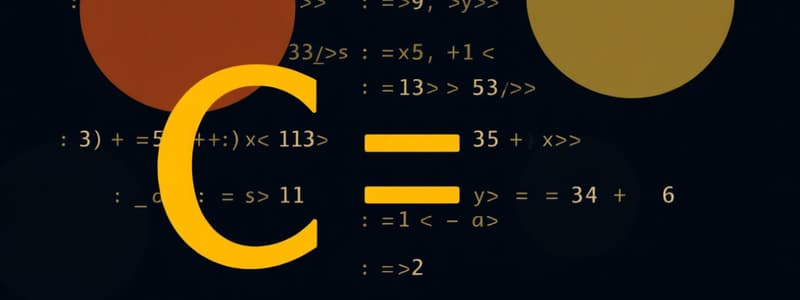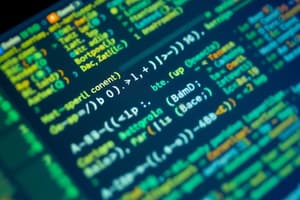Podcast
Questions and Answers
What does the #include preprocessor directive do?
What does the #include preprocessor directive do?
- Includes standard libraries (correct)
- Comments code
- Creates a loop
- Defines variables
What is the format control string used for in printf() or scanf()?
What is the format control string used for in printf() or scanf()?
It specifies how to format the output or input data.
What does the conversion specifier %d indicate?
What does the conversion specifier %d indicate?
It indicates that an integer will be input or output.
How is data read into memory for integers?
How is data read into memory for integers?
What are keywords in C programming?
What are keywords in C programming?
What does the unary increment operator (++ or --) do?
What does the unary increment operator (++ or --) do?
Explain structured programming in your own words.
Explain structured programming in your own words.
The rand() function generates truly random numbers.
The rand() function generates truly random numbers.
In C programming, the function used to generate a random number is called ___
In C programming, the function used to generate a random number is called ___
What does ASCII stand for?
What does ASCII stand for?
Match the following data types with their description:
Match the following data types with their description:
What is the purpose of the break statement in a switch case?
What is the purpose of the break statement in a switch case?
C programming allows single line comments using //.
C programming allows single line comments using //.
What is the main advantage of using a switch statement over an if...else?
What is the main advantage of using a switch statement over an if...else?
What does the conversion specifier %f do?
What does the conversion specifier %f do?
The statement 'n = a + rand() % b;' generates a number within the range of ___ to ___
The statement 'n = a + rand() % b;' generates a number within the range of ___ to ___
Which statement is true about the arithmetic operators in C programming?
Which statement is true about the arithmetic operators in C programming?
What is the effect of using the unary cast operator in a program?
What is the effect of using the unary cast operator in a program?
Which of the following describes valid identifiers in C programming?
Which of the following describes valid identifiers in C programming?
In sequential programming, what is a critical aspect to consider?
In sequential programming, what is a critical aspect to consider?
What distinguishes floating-point types from integer types in C programming?
What distinguishes floating-point types from integer types in C programming?
How do assignment compound operators simplify code?
How do assignment compound operators simplify code?
Which statement accurately reflects the functionality of the printf() function?
Which statement accurately reflects the functionality of the printf() function?
Which of the following correctly describes a binary operator?
Which of the following correctly describes a binary operator?
What is a key feature of using the %f conversion specifier in C programming?
What is a key feature of using the %f conversion specifier in C programming?
Which of the following statements is incorrect regarding structured programming?
Which of the following statements is incorrect regarding structured programming?
What does the term pseudorandom numbers refer to in the context of the rand() function?
What does the term pseudorandom numbers refer to in the context of the rand() function?
How does the keyword 'unsigned' affect an integer type in C programming?
How does the keyword 'unsigned' affect an integer type in C programming?
When does the body of an if statement get executed?
When does the body of an if statement get executed?
What is a correct evaluation of the expression rand() % 6?
What is a correct evaluation of the expression rand() % 6?
What is the significance of RAND_MAX in the context of the rand() function?
What is the significance of RAND_MAX in the context of the rand() function?
Why is understanding string termination crucial in C programming?
Why is understanding string termination crucial in C programming?
What condition will the body of an else statement execute?
What condition will the body of an else statement execute?
In integer data types, what is the cause of integer overflow?
In integer data types, what is the cause of integer overflow?
How does the format specifier impact printf() and scanf() functions?
How does the format specifier impact printf() and scanf() functions?
What is the general syntax format for an if statement?
What is the general syntax format for an if statement?
Flashcards are hidden until you start studying
Study Notes
Comments
- Block comments use
/* */, while single line comments use//. - The
#includepreprocessor directive includes necessary libraries for program functionality. - Preprocessor modifies code before compilation.
- Format control strings define output styles in
printf()orscanf(). - Conversion specifier
%dis used for reading integers. - Reading integers, floating-point numbers, characters, and strings into memory can be demonstrated using
scanf(). - Outputting various data types to the screen is achieved through
printf().
Identifiers
- Identifiers are names for variables, functions, and other entities.
- Valid identifiers follow rules like starting with a letter or underscore; invalid ones include spaces or special characters.
Arithmetic Operators
- Binary operators include
+,-,*,/, and%(remainder). - Order of precedence determines the sequence of operations in calculations.
- Straight-line form represents equations linearly.
Keywords
- Keywords are reserved words in C that have special meanings.
Cast Operator
- A unary cast operator changes a variable's data type temporarily.
Floating-point Numbers
%fis used inscanf()andprintf()for floating-point numbers.- Field width and precision can be specified with
%f.
Assignment Compound Operators
- Operators like
+=,-=,*=,/=, and%=simplify assignment operations.
Increment/Decrement Operators
++(increment) and--(decrement) modify values by one, with pre and post-forms differing in execution timing.
Structured Programming
- Structured programming emphasizes a clear and logical flow in code, executing in sequence.
Data Types
- C has four primary data types:
int,char,float, anddouble. - Integer types differ from floating-point types, with modifiers like signed, unsigned, short, and long available.
Whitespace and Programming Standards
- Good coding practices require clear and readable code to enhance understanding.
Random Numbers and the C Standard Library
rand()generates pseudorandom numbers;srand()seeds the random number generator.- The range of
rand()is determined byRAND_MAX, which defines the maximum value. - Random numbers in a specified range can be generated using the formula
n = a + rand() % b.
Characters
- Characters are stored in memory as ASCII values, which provide a standardized representation.
Strings
- Strings are sequences of characters terminated by a null character, crucial for proper string handling.
Data Type (Signed and Unsigned)
- Signed types can represent both positive and negative values, while unsigned types only represent non-negative values.
- Integer overflow occurs when a value exceeds the maximum limit that can be stored in the data type.
Format Specifiers for printf() and scanf()
- Format specifiers dictate how data is formatted in input and output functions.
Branches (Chapter 3)
- The
ifstatement's syntax dictates execution based on conditions, with the body enclosed in curly braces. if…elsestructures allow for alternative execution paths.- The conditional operator
?:serves as a shorthand forif…else. - The
switchstatement compares values and executes matching cases, requiringbreakto exit.
Boolean
#include <stdbool.h>allows the use of boolean values in C programming, withtrueandfalserepresenting conditions.
String Comparisons
- Functions like
strcmp(),strlen(), andstrcat()are essential for managing string operations in C.
Floating-point Comparison
- Floating-point comparisons require a threshold (epsilon) to account for precision issues.
Short Circuit Evaluation
- Short-circuit evaluation improves efficiency by stopping evaluation once the truth value is determined.
Introduction to C Programming
- Comments can be in two forms: block style (/.../) and single line (//).
- The #include preprocessor directive includes libraries in C, necessary for using standard functions.
- Preprocessor directives are commands that instruct the compiler to pre-process the source code.
- A format control string specifies how data should be formatted in printf() and scanf().
- Conversion specifier %d is used for reading and printing integers.
- Input integers can be read into memory using scanf() with the %d specifier.
- Floating-point numbers are read into memory with the %f specifier in scanf().
- Characters and strings can be read into memory using %c and %s format specifiers.
- Output can be displayed to the screen using printf() for text, integers, floating-point numbers, and strings.
- Demonstrative print statements can show results of calculations, e.g., printf("%d", 11+76).
Identifiers and Operators
- An identifier is a name given to entities in C (variables, functions, etc.).
- Valid identifiers follow naming rules; invalid identifiers violate these rules.
- Binary operators perform operations on two operands, including arithmetic operators: +, -, *, /, %.
- The remainder operator (%) gives the remainder of a division.
- Order of precedence dictates the order to evaluate expressions with multiple operators.
- Associativity rules determine how operators of the same precedence are evaluated.
- Straight-line form in programming simplifies the understanding of complex equations.
Keywords and Cast Operators
- Keywords are reserved words in C that have special meanings and cannot be used as identifiers.
- A unary cast operator converts data from one type to another, changing its type.
Floating Point Numbers
- %f is used with scanf() and printf() for handling floating-point numbers.
- Field width and precision can be specified with the %f conversion specifier for formatting.
Assignment and Increment/Decrement Operators
- Compound operators (+=, -=, etc.) provide shorthand for performing arithmetic and assignment.
- Unary increment (++) and decrement (--) operators increase or decrease a value by one, usable in pre or post forms.
Structured Programming
- Structured programming emphasizes clear, identifiable blocks of code.
- Sequential programming executes statements one after another, maintaining order.
Data Types
- The fundamental data types in C include int, char, float, and double.
- Integer types hold whole numbers, while floating-point types represent decimal values.
- Modifiers like signed, unsigned, short, and long alter the characteristics of data types.
- Understand ASCII values to represent characters and integers.
Whitespace and Programming Standards
- Writing readable code is essential for maintainability and collaboration.
- Proper indentation and organization enhance code clarity.
Random Numbers and C Standard Library
- rand() generates random numbers; srand() seeds the random number generator.
- Pseudorandom numbers mimic randomness while being deterministic.
- The output range of rand() is determined by RAND_MAX.
- To generate numbers within a specific range, use the formula n = a + rand() % b.
Characters and Strings
- Characters are represented in memory through their ASCII equivalents.
- Strings are arrays of characters terminated by a null character (i.e., '\0') for proper handling.
Integer Overflow
- Integer overflow occurs when a value exceeds the maximum limit for a data type, causing unexpected behavior.
- Understanding overflow is critical for effective C programming.
Format Specifiers
- Format specifiers define the type and format of output in printf() and scanf(), crucial for data representation.
- Familiarization with specific format specifiers aids in data handling and display.
Branching and Selection Statements
- The syntax and execution of the if() statement control conditional logic.
- The body of an if statement is executed based on condition evaluation.
- The if...else structure allows branching into alternative code paths based on conditions.
- The conditional operator (?:) offers a concise way to handle simple conditional expressions.
Studying That Suits You
Use AI to generate personalized quizzes and flashcards to suit your learning preferences.




